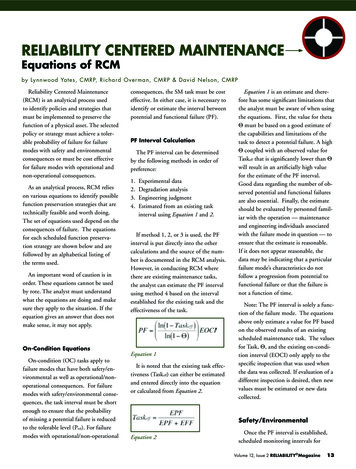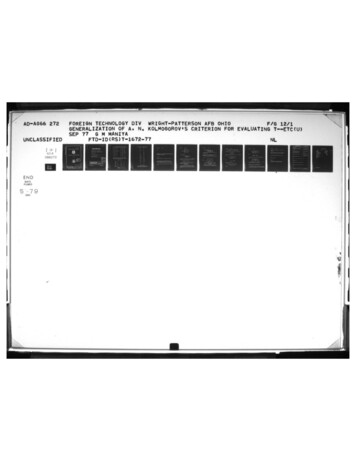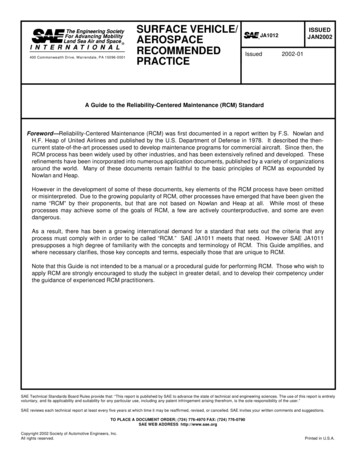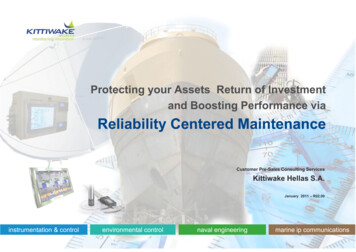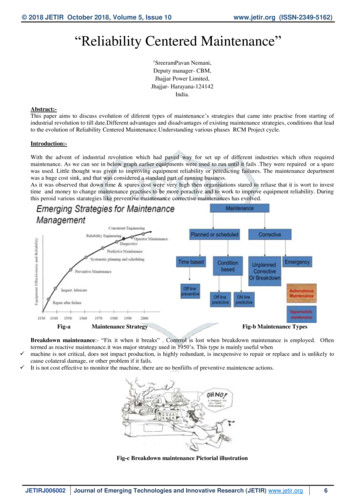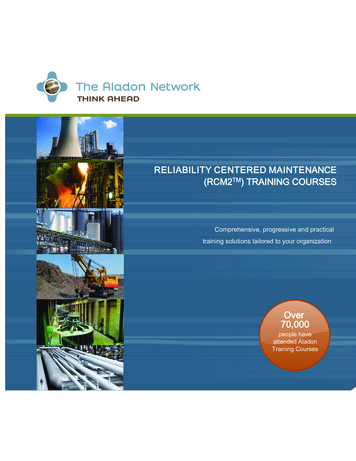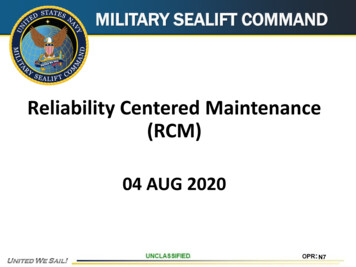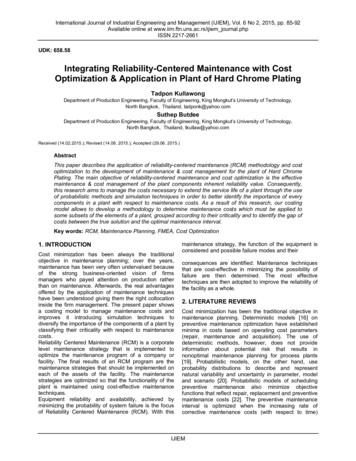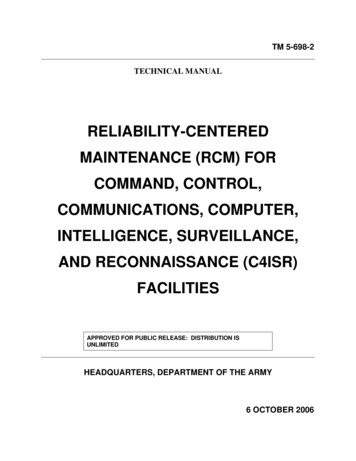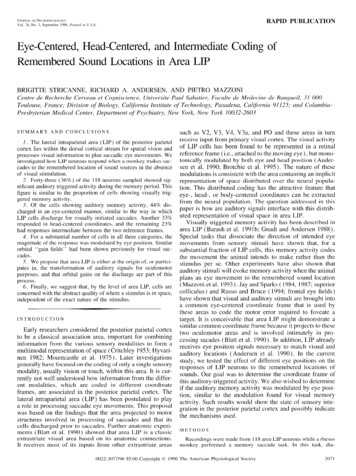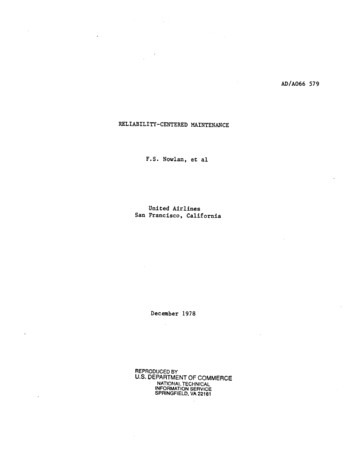
Transcription
AD/A066 579RELIABILITY-CENTEREDF.S. Nowlan,MAINTENANCEet alUnited AirlinesSan Francisco,CaliforniaDecember 1978REPRODUCEDBYU.S. DEPARTMENTOF COMMERCENATIONAL TECHNICALINFORMATION SERVICESPRINGFIELD, VA 22161
UnclassifiedECUR,TYCL*SSIF,C*TIONOF THIS PACEImenD.,.REPORTDOCUMENTATION1. REPORTEnr*rw2. GO”7NVMWERREAD INSTRUCTIONSBEFORECOMPLEmNGPAGEACCESSIONNO.3. *EC,C,ENT*SCC.TALOGFORMNUMBERReliability-Centered Maintenance7.0.*“THORfa,cONTR*CTORGRIN7N”MBE.q ,F. Stanley NowlanMDA 903-75-C-0349Howard F. Heap9. PERFORMlNGORGAN,ZATlONNAMEANDADDRESSUnited AirlinesSan Francisco International AirportSan Francisco, Ca 9412817.REPORTDATEII. ce of Assistant Secretary of Defense13.NUHBEROFPACES(Manpower, Reserve Affairs and Logistics)476Washington, DC 2030118.MON,TOR,NCAGENCYNAMEL *ooRESSf,td‘lhmll*ran!Cmtmlllngoffice) ed for public release;distribution unlimited. Copies may be obtained fromthe National Technical Information Service or the Defense Documentation Center.This work was performed by United Airlines under the sponsorship of theOffice of Assistant Secretary of Defense (Manpower, ReserveAffairs and 1,nes***ynd idenlWby*rocknwb*r,Actuarial analysis Aircraft maintenance Cost effectiveness Decision theoryEvaluationFailure effects Flight safety Logistics Maintenance programMechmidsafety Preventive maintenance Product improvementReliabilityScheduled maintenance System effectiveness10.AWSTRACT(ConrmueonICVDIS.richI, neae*.*ryandId.“lffybyblocknwlb r,This book explains basic concepts, principles, definitions, and applications of alogical discipline for development of efficient scheduled (preventive1 maintenanceprograms for complex equipment, and the on-going managementof such programs.Such programs are called reliability-centered maintenance (RCM) programsbecausethey are centered on achieving the inherent safety and reliability capabilities ofDD , ::,“:,1473EO,TIONOF I NO” 65 1sOBSOLETEUnclassified
Unclassifiedequipmentat a minimumcost. A U.S. Departmentof Defense objective in sponsoring preparationof this documentwas that it serve as a guide for applicationto awide range of different types of militaryequipment.There are essentiallyonly four types of tasks in a scheduledMechanics can be asked to:InspectReworkDiscardInspectto themaintenanceprogram.an item to detect a potentialfailurean item before a maximumpermissibleage is exceededan item before a maximumpermissibleage is exceededan item to find failures that have already occurred but were not evidentequipmentoperating crewA central problem addressed in this book is how to determine which types of scheduled maintenancetasks, if any, should be applied to an item and how frequentlyassigned tasks should be accomplished.The use of a decision diagram as an aid inthis analysis is illustrated.The net result is a structured,systematic blend ofexperience,judgment,and operationaldata/informationto identify and analyzewhich type of maintenancetask is both applicableand effective for each significantitem as it relates to a particular type of equipment.A concludingchapter emphasizesthe key importanceof having a mutuallysupportivepartnershipbetween the personnel responsiblefor equipmentdesign and the personnel responsiblefor equipment maintenanceif maximum RCM results are to be achieved.Appendicesare includedProceduresas follows:for auditingthe developmentA historicalreview of equipmentmaintenanceTechniquesof performingactuarial analysesAn annotated bibliographyDD , ::FJs 1473EDITIONOFI NO”66IS OBSOLETEand implementationevolutionUnclassifiedof an RCM
AD/A066 579RELIABILITY-CENTEREDMAINTENANCE
reliability-centered;J.,.
maintenanceF. STANLEY NOWLANDirector, MaintenanceUnited AirlinesHOWARDAnalysisF. HEAPManager, Maintenance Program PlanningUnited Airlines
Produced by Dolby Access PressDesigner Nancy Clark, illustrators David A. Strassmanand EvaneU Towne, compositor Jonathan D. Peck,printer Braun-Brumfield,Inc.
prefaceTHIS VOLUMEprovidesthe first full discussionof reliability-centeredmaintenanceas a logical discipline for the developmentof scheduledmaintenanceprograms.The objective of such programs is to realize theinherentreliabilitycapabilitiesof the equipmentfor which they aredesigned, and to do so at minimumcost. Each scheduled-maintenancetask in an RCM program is generated for an identifiableand explicitreason. The consequencesof each failure possibilityare evaluated, andthe failures are then classified according to the severity of their consequences. Then for all significantitems- those whose failure involvesoperating safety or has major economic consequences- proposed tasksare evaluated according to specific criteria of applicabilityand effectiveness. The resultingscheduled-maintenanceprogram thus includes allthe tasks necessary to protect safety and operating reliability,and onlythe tasks that will accomplishthis objective.Up to this point the only document describingthe use of decisiondiagrams for developingmaintenanceprogramshas been MSG-2, thepredecessorof RCM analysis. MSG-2 was concerned primarilywith thedevelopmentof prior-to-serviceprograms and did not cover the use ofoperatinginformationto modify the maintenanceprogram after theequipmententers service or the role of product improvementin equipment development.’The chief focus was on the identificationof a set oftasks that would eliminate the cost of unnecessarymaintenance withoutcompromisingsafety or operating capability. There was no mention ofthe problem of establishingtask intervals,of consolidatingthe tasksinto work packages, or of making decisions where the necessary information is unavailable. The treatment of structure programs was sketchy,and zonal and other general inspectionprogramswere not discussedat all.vii
.VU1The difficulty that many people experienced in attempting to applythe concepts of MSG-2 indicated the need for changes and additionssimply to clarify many of the points. It was also abundantlyclear, however, that the scope of the material should be expanded to cover the topicsthat had not been discussedin that document. This volume includes amajor expansion of the discussionon the problem of identifyingfunctionally and structurallysignificantitems. The RCM decision diagramitself is quite different from the one used for MSG-2. Instead of beginningwith the evaluation of proposed maintenancetasks, the decision logicbegins with the factor that determines the maintenance requirementsofeach item - the consequencesof a functional failure- and then an evaluation of the failure modes that cause it. This new diagram also recognizes the four basic maintenancetasks that mechanicscan perform(instead of three maintenanceprocesses),thereby clarifyingthe treatment of items with hidden functions.The role of a hidden-functionfailure in a sequence of multiple independentfailures is stressed, andit is also shown that the consequencesof a possible multiple failure areexplicitly recognizedin the definitionof the consequencesof the firstfailure.Anotherimportantaspect of the RCM decision logic is that itincludes a default strategy for making initial maintenancedecisions inthe absence of full information.There is a full discussionof the problemof assigningtask intervals,particularlythose for first and repeat oncondition inspections.The role of age exploration and the use of information derived from operating experience, both to modify the initialmaintenance program and to initiate product improvement,is discussedat length. The content of scheduled-maintenanceprogramsdevelopedby experienced practitionersof MSG-2 techniques may be quite similarto the programs resulting from RCM analysis, but the RCM approach ismore rigorous,and there should be much more confidence in its outcome. The RCM technique can also be learned more quickly and is morereadily applicable to complex equipment other than transportaircraft.Part One of this volume presents a full explanationof the theoryand principlesof reliability-centeredmaintenance,including a discussion of the failure process, the criteria for each of the four basic tasks,the use of the decision logic to develop an initial program, and theage-explorationactivities that result in a continuingevolution of thisprogramafter the equipmententers service. Part Two describestheapplicationof these principlesto the analysis of typical items in thesystems, powerplant,and structure division of an airplane; the considerations in packaging the RCM tasks, along with other scheduled tasks,for actual implementation;and the informationsystems necessary formanagementof the ongoing maintenanceprogram.The concludingchapter discusses the relationshipof scheduled maintenanceto operating safety, the design-maintenancepartnership,and the application of
RCM analysis both to in-servicefleets and to other types of complexequipment.The text is followed by four appendices.AppendixA outlines theprinciplesof auditinga program-developmentproject and discussessome of the common problems that arise during analysis. This materialprovides an excellent check list for the analyst as well as the auditor andshould be especially useful as a teaching aid for those conducting training groups in RCM methods. AppendixB is a historicalreview of thechanges in maintenancethinkingin the airline industry.Appendix C isa discussionof the engineeringproceduresand techniquesused inactuarial analysis of reliabilitydata. AppendixD, writtenby Dr. JamesL. Dolby, is a discussionof the literature in reliability theory, informationscience, decision analysis, and other areas related to RCM analysis andprovides an annotated guide to this literature as well as to the specificliterature on reliability-centeredmaintenance.Dr. HowardL. Resnikoffhas writtenan accompanyingmathematicaltreatmentof the subject,titled Mathematical Aspects of Reliability-CenteredMaintenance.A book of this nature is the result of many efforts, only a few ofwhich can be acknowledgedhere. First of all, we wish to.express ourgratitude to the late W. C. Mentzer, who directed the pioneeringstudiesof maintenancepolicy at United Airlines,and to the Federal AviationAdministrationfor creating the environmentin which this work wasdeveloped over the last twenty years. We also thank Charles S. Smithand Joseph C. Saia of the Departmentof Defense, who defined the content of the present text and counseled us throughoutits preparation.James L. DoIby of San Jose State University,in addition to preparingthe bibliography,contributedhis expertise to the text. In particular,he helped to develop the concept of partitioningto identify significantitems and the concept of default answersas part of the decision logic,as well as advising us on the actuarial appendix.Nancy Clark editedour efforts and organized them for clear exposition.Her logical thoughtprocesses resulted in numerousmajor improvementsthroughoutandmade possible the successfultranslationof our manuscriptto textbookform.Much help on specific areas of the text has come from friends andcoworkersin the industry.We especially wish to thank Mel Stone ofDouglas Aircraftfor his extensive help with the structure chapter, JohnF. McDonald of the Flying Tiger Line for his comments on the theoreticalchapters, and John F. Pirtle of General Electric for his comments on thepowerplantchapter. Of the many others whose contributionsinfluencedthe text in some importantrespect, we give particular thanks to ThomasM. Edwards of United Airlines, Thomas D. Matteson of United Airlines,Ernest Boyer of the Federal Aviation Administration,Captain L. Ebbertof the U.S. Navy, Edward L. Thomas of the Air TransportAssociation,and Robert Gard of the Universityof Missouri.ix
We are also grateful to the many people at United Airlines who provided us with specific help and assistance. The manuscriptitself wouldnot have materializedwithout the efforts of Marie Tilson, who cheerfullytyped and retyped the material through many drafts. We also thankClaudia Tracy, whose artworkmade the draft manuscriptmore readable,and J. Douglas Burch, whose efforts throughoutthe project helped bringit to completion.Finally, we would like to thank the managementofUnited Airlines for its patience and our wives for their encouragementover the many long months of authorshipand publication.F. Stanley NowlanHoward F. Heap
contentsviiPREFACEA MAINTENANCExviPHILOSOPHYcwwE 0 Et cm:am;u 'ntenancediscipline1-lTHE EVOLUTIONi-2THE BASISl-3RELIABILITYl-4AN OVFAVIEWOF RCMOF RCMANALYSISDECISIONPROBLEMS24LOGICIN COMPLEXOF natweof2’ 1THE DEFINITIONOF FAILURE2.2THE DFXECTIONOF FAILURES2.3THE CONSEQUENCES2-4MULTIPLE2.5THE FAILURE2 6FAILUREFAILURESPROCESSIN COMPLEXhib’e161720OF FAILURE252831ITEMSTHEORYAND PRINCIPLES37XI15
2.7QUANTlTATlVEDFSCRlPTlONS2.8AGE-REllA8IMTYOF FAILURECHARACTFXlSTlCSCHAPTER DlTlON3 *zSCHFDuLEDREWORKTASRS563 C3 -5CHARACTERISTKSOF THE BASIC3-6THE DIMENSIONSOF A SCHEDULED-MAINTENANCE3 *7PRODUCTCHAPTER FOUR4. ITHE NATURE4-2THE RCM4.3USE OF THE RCM4.4DETERMINING4.5AGE AMEFFECllVENESS100106THE MAlNTENANCETHE USES OF OPERATlNC5-2REACTlNC5-3REFININGTHE MAlNTENANCE5.4RFMSIONSIN MAlNTENAN5.5THE PRODUCT-IMPROVEMENT5.6RCMTO SERIOUS109TASKS4?VOiUtiOn5 *1PROGRAMSTASKSclevdopingDECISIONCHAPTER FIVE61AS PREW.NTWOF SIGNIACANT5051TASKSIMPROVEMENTtit&SOf theDATA113FAlLURES116PROGRAM121126CE REQUIREMENTSFOR IN-SERVlCEranPROCESSEQUIPMENT128137propam1x1
PARTTWOCHAPTERSIXtheorytcmircdtdp@yit83rCm6.1A SUMMARYOF RCM6-2ORGANIZATION6.3BEGINNING6.4THE CS7.2ASSEMBUNCIN OF SYSTEJMS ITFMSTHE REQUIREDOF W@'SiS8-lCHARACTERlS’flCS8.2ASSFMBLINCOF POWERPlANT8.3FAILURESOF THE BASIC8.4FAILURESOF SECONDARY8-5THE ROLE OF AGE EXPLORATIONTHE CTF.REDCS9-2THE IONINSPECTIONAGE EXPLORATIONof structuresITEMSPLANOF STRUCTURALINITLAL217224OF STRUCTURALTHE REQUllub194195INFORMATIONCHAPTER NINE rem VEN rcmandysisof7 *1140141OF THE PROGRAM-DEVELOPMENTTHE 39
CHAPTER TEN10-lOTHERIO.2PACKAGINGCOmpletiU ELEVENthe use of opentinsI 1-lTYPICALINFORMATION11-2TYPICALTYPES OF ROUTINE11.3MODIFYINGTHE MAINTENANCE11.4INlERVAL!kAN TER TWELVE12-lSAFETY, RElIABILllY,12 -2AIR-TRANSPORT12.3THE DESIGN-MAINTENAN12.4RCM12 -5FXPANSIONANALYSIS301PROGRAM307PROGRAM324OF OPINIONtheAND325deOf SChdUkdSCHEDULEDLEVELSFOR IN-SERVICE3313.41FLEETSAPPLICATIONSGUIditi 330337343347PART THREEAPPENDIX AIUdwCeMAINTENANCECE PARTNWHIPOF RCM292328SAFElYPROGRAMSinfonnntion293SYSTEMSTHE PROGRAM276277TASKSTHE MAINTENANCEprOg APPENDICESI-Cm PrOgKUUA.1AUDITINGTHE PROGRAM-DEVELOPMENTA-2AUDITINGTHE DECISIONA-3AUDITINGANALYSISA-4AUDITINGTHE ONGOINGA-5AUDlllNGNEW PROGRAMSPROCESSPROjECT351354OF THE EQUIPMENTPROGRAMw362367FOR IN-SERVICEFLEETS368349350
APPENDIX B the history of ran proyamsB* ITHE HARD-TIMEPARADOXB-2CHANGINGB-3THE INTRODUCTIONOF ON-CONDITIONB-4THE AIR TRANSPORTASSOCIATIONB-5THE RELATIONSHIP371PERCEPTlONSAPPENDIXCOF THE HARD-TIME1 ANDOF LIFE-TESTC-2ANALYSISOF DATAC-3THE SMOOTHINGC-4ANALYSISC.5USEJULC-6A SPECIALD- NANCEAPPLICATlONS0.6A GUIDE391A VFLOPMENTTO OTHERPERIOD402411USE OF THE RAMS390ANALYSISFROM383TO C* 1INDEXPOLICYMAINTENANCEMSG-OF SCHEDULEDOF A 36438ANALYSIS430427385SAFETY387
literature on reliability-centered maintenance. Dr. Howard L. Resnikoff has written an accompanying mathematical treatment of the subject, titled Mathematical Aspects of Reliability-Centered Maintenance. A book of this nature is the result of ma
